OriginLabs houses all of the latest tools and equipment needed for woodworking, metalworking, welding, surfacing/finishing, electronics prototyping, CNC, additive manufacturing, and digital fabrication from world-class manufacturers. Explore our extensive collection of equipment and download the corresponding standard operating procedures (SOP) to ensure safe and efficient operation.
For a full list of upcoming equipment training, check out our Training page.
-
CNC Router

The CNC (computer numerical control) router is an automated cutting tool. A mechanized gantry moves an electric spindle in three axes to cut, mill, or mark materials such as wood, foam, and certain plastics. The spindle accepts router bits of various profiles, capable of achieving different results, and OriginLabs maintains a comprehensive library of tools. The CNC router is outfitted with a vacuum hold-down and ten-position automatic tool changer and is capable of processing 4’x8’ sheets of material.
Pricing:
General projects – $25.00/per hour
Penn State-affiliated – $20.00/per hour -
Sliding Table Panel Saw

The Sliding Table Panel Saw is a table saw outfitted with a sliding table and support outrigger with adjustable miter fence that glides back and forth on a fixed rail system. Because the operator can effortlessly pass large, cumbersome, and/or heavy materials through the blade in a safe and controlled fashion, this tool excels at breaking down sheet goods and straight-line-ripping raw lumber. The saw is outfitted with a scoring blade, 10’ sliding table, and an overhead guard/dust shroud.
-
Combination Planer Jointer
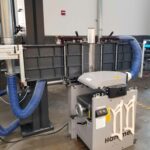
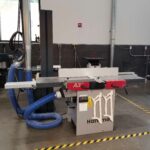 As its name suggests, this tool combines a planer and a jointer into a single unit which can be switched between operations quickly. The jointer allows for the flattening and surface finishing of cupped, warped, or otherwise rough lumber. The planer allows for the thicknessing of boards to an exact dimension and ensures both faces of a board are coplanar. The machine can joint and plane/thickness boards up to 16” wide.
As its name suggests, this tool combines a planer and a jointer into a single unit which can be switched between operations quickly. The jointer allows for the flattening and surface finishing of cupped, warped, or otherwise rough lumber. The planer allows for the thicknessing of boards to an exact dimension and ensures both faces of a board are coplanar. The machine can joint and plane/thickness boards up to 16” wide. -
Bandsaws
 OriginLabs has two bandsaws, each dedicated to different types of operations. Both allow for freehand cutting or cutting guided by fence or miter gauge. The large bandsaw is intended for ripping and resawing (sawing one thick board into two or more thinner boards), and the smaller bandsaw is meant for scrolling, curvilinear cuts.
OriginLabs has two bandsaws, each dedicated to different types of operations. Both allow for freehand cutting or cutting guided by fence or miter gauge. The large bandsaw is intended for ripping and resawing (sawing one thick board into two or more thinner boards), and the smaller bandsaw is meant for scrolling, curvilinear cuts. -
Edge Sander

This tool excels at developing a smooth and straight edge on longer, linear parts. The flat portion of the belt can also be used to shape irregular parts with facets or convex curves. The end of the belt, at the idler wheel, can be used to shape concave curves.
-
Oscillating Spindle Sander

This tool is excellent for sanding concave curves and profiles. Multiple spindle sizes are available and can be easily changed, thereby allowing for the sanding of curves with various radii.
-
Table Saw

The table saw is designed to accurately make straight, perpendicular, or parallel cuts in materials that already have one straight edge. The straight edge of the work piece is guided along the machine’s fence or miter gauge while being passed through the saw blade. This process allows for safe and accurate sizing of parts to exact dimensions. This tool is outfitted with body-contact-sensing technology and an overhead guard/dust shroud.
-
Miter Saw
 The miter saw excels at sizing linear stock to exact dimensions and precise angles. The compound miter saw is capable of miter, bevel, or compound (miter and bevel) cuts. This tool is used extensively in trim carpentry operations, and for making items like picture frames, small boxes, and furniture or casework components.
The miter saw excels at sizing linear stock to exact dimensions and precise angles. The compound miter saw is capable of miter, bevel, or compound (miter and bevel) cuts. This tool is used extensively in trim carpentry operations, and for making items like picture frames, small boxes, and furniture or casework components. -
Drill Press

The drill press allows the user to bore holes of various diameters in a controlled and highly accurate way. Materials can be clamped securely to the table, and settings are provided for limiting the depth of plunge, and the angle of the hole drilled.
-
HVLP System
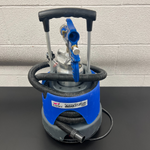 HVLP stands for “high volume, low pressure”, which means that this sprayer delivers a large amount of paint using very little air, which is generated by the onboard turbine. Functionally, this means that paint application is easy to control and overspray is minimized. Various types of paint can be run through this system but must be thinned to the proper viscosity. This includes automotive paints, alcohol-thinned lacquers, and even cheap latex house paint thinned with water.
HVLP stands for “high volume, low pressure”, which means that this sprayer delivers a large amount of paint using very little air, which is generated by the onboard turbine. Functionally, this means that paint application is easy to control and overspray is minimized. Various types of paint can be run through this system but must be thinned to the proper viscosity. This includes automotive paints, alcohol-thinned lacquers, and even cheap latex house paint thinned with water.
-
TIG Welder
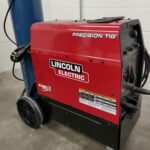 TIG (Tungsten Inert Gas) welding utilizes a tungsten electrode, inert gas, manually introduced filler rod, and electricity to create a high temperature arc that is extremely clean and precise. This method of welding requires a high degree of coordination and practice, and is well suited to exacting projects using aluminum, mild steel, or stainless steel.
TIG (Tungsten Inert Gas) welding utilizes a tungsten electrode, inert gas, manually introduced filler rod, and electricity to create a high temperature arc that is extremely clean and precise. This method of welding requires a high degree of coordination and practice, and is well suited to exacting projects using aluminum, mild steel, or stainless steel. -
MIG Welder
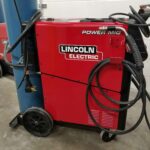
MIG (Metal Inert Gas) welding utilizes automatically introduced filler wire, inert gas, and electricity to create a high temperature arc capable of melting a wide range of metal thicknesses. This process is easy to learn the basics and is best suited to welding mild steel.
-
Plasma Cutter
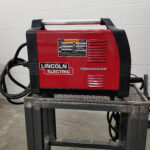 The plasma cutter allows for freehand or guided (using a jig or straight edge) cutting of various sheet metal types and thicknesses. Plasma is the combination of compressed air and a high-temperature electrical arc.
The plasma cutter allows for freehand or guided (using a jig or straight edge) cutting of various sheet metal types and thicknesses. Plasma is the combination of compressed air and a high-temperature electrical arc. -
Fixturing Table
 This tool is used in conjunction with the MIG and TIG welder to fixture loose project pieces securely to a flat surface, in the desired orientation, so that they can be welded together.
This tool is used in conjunction with the MIG and TIG welder to fixture loose project pieces securely to a flat surface, in the desired orientation, so that they can be welded together.
-
High-Wattage Laser
-
Box and Pan Brake
-
Hydraulic Shear
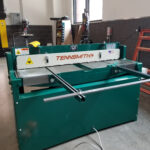 This tool quickly and easily cuts sheet metal to size. The shear can handle sheets up to 52” wide and can process up to 16-gauge mild steel.
This tool quickly and easily cuts sheet metal to size. The shear can handle sheets up to 52” wide and can process up to 16-gauge mild steel. -
Electric Slip Roll

This powered tool is used to form flat sheet, bar, or rod stock into curved profiles. This slip roll can handle 16-gauge mild steel and has a 50” width.
-
Horizontal Band Saw
 This tool is primarily used to cut linear tube, rod, bar, and angle stock to length. It can also be used in the vertical orientation for sheet metal.
This tool is primarily used to cut linear tube, rod, bar, and angle stock to length. It can also be used in the vertical orientation for sheet metal. -
Drill Press
 The drill press allows the user to bore holes of various diameters in a controlled and highly accurate way. Materials can be clamped securely to the table, and settings are provided for limiting the depth of plunge and the angle of the hole drilled.
The drill press allows the user to bore holes of various diameters in a controlled and highly accurate way. Materials can be clamped securely to the table, and settings are provided for limiting the depth of plunge and the angle of the hole drilled. -
Belt Sander
 This tool is designed for processing metals and uses an abrasive belt to shape workpieces and/or remove surface imperfections. The belt is less abrasive than the coarse grinding stones on the bench grinder.
This tool is designed for processing metals and uses an abrasive belt to shape workpieces and/or remove surface imperfections. The belt is less abrasive than the coarse grinding stones on the bench grinder. -
Bench Grinder
 This tool is designed for processing metals and uses coarse grinding stones to shape and abrade surfaces.
This tool is designed for processing metals and uses coarse grinding stones to shape and abrade surfaces.
-
Laser Engravers
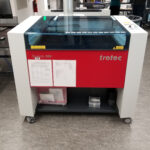 Laser engravers use amplified light to selectively burn a substrate in an extremely precise and controlled manner. These machines can interpret and process files from many popular design software and are able to mark, engrave, or completely cut various materials, such as wood, paper, some plastics, and natural fibers. OriginLabs has two Trotec Speedy 360 machines capable of processing 32” x 20” sheets of material.
Laser engravers use amplified light to selectively burn a substrate in an extremely precise and controlled manner. These machines can interpret and process files from many popular design software and are able to mark, engrave, or completely cut various materials, such as wood, paper, some plastics, and natural fibers. OriginLabs has two Trotec Speedy 360 machines capable of processing 32” x 20” sheets of material.Pricing:
General projects – $7.50/per hour
Penn State-affiliated – $6.00/per hour -
Vinyl Printer/Cutter/Plotter
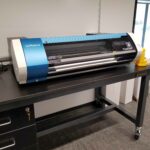 This tool allows the user to print high-quality images for use as stickers, logos, posters, or heat transfers, depending on the type of media loaded into the machine.
This tool allows the user to print high-quality images for use as stickers, logos, posters, or heat transfers, depending on the type of media loaded into the machine. -
CNC Mill
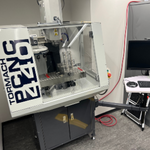 The CNC (computer numerical control) mill is an automated cutting tool that can produce highly accurate parts in aluminum, plastics, and mild steel. An electric spindle spins a rotary cutting tool to remove material from a “blank”. The Tormach PCNC 440 is a 3-axis machine, has a fully enclosed working envelope of 10” x 6.25” x 10”, and includes an 8-position automatic tool changer.
The CNC (computer numerical control) mill is an automated cutting tool that can produce highly accurate parts in aluminum, plastics, and mild steel. An electric spindle spins a rotary cutting tool to remove material from a “blank”. The Tormach PCNC 440 is a 3-axis machine, has a fully enclosed working envelope of 10” x 6.25” x 10”, and includes an 8-position automatic tool changer.Pricing:
General projects – $25.00/per hour
Penn State-affiliated – $20.00/per hour -
CNC Lathe
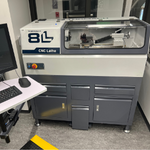 The CNC (computer numerical control) lathe is an automated cutting tool that can produce highly accurate parts in aluminum, plastics, and mild steel. An electric spindle spins a “blank” of raw material, while a cutting tool is moved in the X and Z axes to remove material and create radial profiles. The Tormach 8L has a fully enclosed working envelope, an 8” maximum swing over bed, and 4” maximum swing over carriage.
The CNC (computer numerical control) lathe is an automated cutting tool that can produce highly accurate parts in aluminum, plastics, and mild steel. An electric spindle spins a “blank” of raw material, while a cutting tool is moved in the X and Z axes to remove material and create radial profiles. The Tormach 8L has a fully enclosed working envelope, an 8” maximum swing over bed, and 4” maximum swing over carriage.Pricing:
General projects – $25.00/per hour
Penn State-affiliated – $20.00/per hour -
Soldering Station
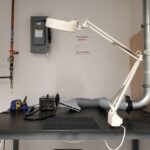 The soldering station is used extensively in microelectronics applications for creating secure and electrically conductive connections between components.
The soldering station is used extensively in microelectronics applications for creating secure and electrically conductive connections between components.
-
SLA Printer

SLA (Stereo Lithographic Apparatus) printing yields high resolution parts with impressive surface quality, very small hole and pin details, and high fidelity to the originating CAD model. These printers use a laser to cure a photo-sensitive plastic resin. Resins come in multiple formulations which allow for monochromatic prints in various colors, different durometers of flexibility, or other physical characteristics such as heat resistance, rigidity, or elasticity. The Formlabs Form3+ can print an object roughly 6” cubed, while the Form 3L can print objects the size of a bicycle helmet.
-
SLS Nylon Printer
SLS (Selective Laser Sintering) printers use a laser beam to melt and fuse powder. This process yields robust parts with good surface finish and high fidelity to the originating CAD model. The Formlabs Fuse 1+ has a build volume of 6.5” x 6.5” x 11.8” and prints Nylon or TPU for end-use parts that are ductile and impact resistant.
-
SLS Metal Printer
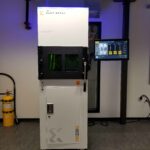 SLS (Selective Laser Sintering) printers use a laser beam to melt and fuse powder. This process yields robust parts with good surface finish and high fidelity to the originating CAD model. The Xact Metal XM200G has an approximate build volume of 6” cubed and prints 316L stainless steel end-use parts.
SLS (Selective Laser Sintering) printers use a laser beam to melt and fuse powder. This process yields robust parts with good surface finish and high fidelity to the originating CAD model. The Xact Metal XM200G has an approximate build volume of 6” cubed and prints 316L stainless steel end-use parts. -
Polyjet Printer
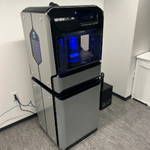 Polyjet printers jet liquid resin droplets that are hardened by UV light. This jetting process mirrors a standard inkjet printer and likewise enables dynamic color mixing. The Stratasys J55 can print the full Pantone range and even full-color, realistic copies of 3D laser scanned objects.
Polyjet printers jet liquid resin droplets that are hardened by UV light. This jetting process mirrors a standard inkjet printer and likewise enables dynamic color mixing. The Stratasys J55 can print the full Pantone range and even full-color, realistic copies of 3D laser scanned objects.
-
Collaborative Robots
 Collaborative robots have several distinct advantages over industrial robots, especially in educational settings and small to medium sized manufacturing environments. They do not require knowledge of a complex programming language, are highly mobile, and do not require any safety interlocks such as laser/light curtains or enclosures. Like their industrial counterparts, these arms can be fitted with various end-affectors such as grippers, welders, sanders, and more. The Universal Robots UR10e units have a payload capacity of 10kg (22 lbs.) and a reach radius of about 51”.
Collaborative robots have several distinct advantages over industrial robots, especially in educational settings and small to medium sized manufacturing environments. They do not require knowledge of a complex programming language, are highly mobile, and do not require any safety interlocks such as laser/light curtains or enclosures. Like their industrial counterparts, these arms can be fitted with various end-affectors such as grippers, welders, sanders, and more. The Universal Robots UR10e units have a payload capacity of 10kg (22 lbs.) and a reach radius of about 51”.





